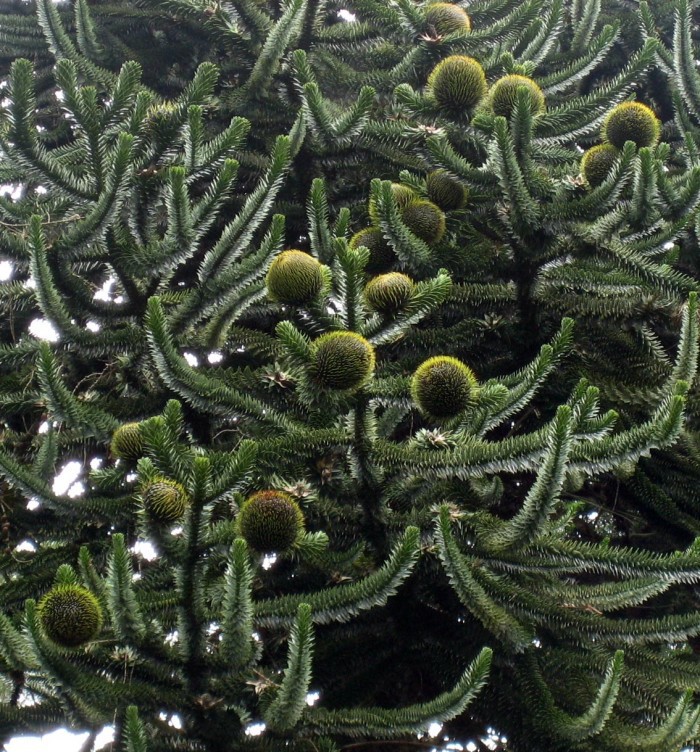Araucaria is a genus of evergreen coniferous trees in the family Araucariaceae. There are 19 extant species in the genus, with a Gondwanan natural distribution in New Caledonia (where 13 species are endemic), Norfolk Island, eastern Australia, New Guinea, Argentina, Chile, and southern Brazil.
Araucaria are mainly large trees with a massive erect stem, reaching a height of 30-80 metres (98-260 ft). The horizontal, spreading branches grow in whorls and are covered with leathery or needle-like leaves. In some species, the leaves are narrow awl-shaped and lanceolate, barely overlapping each other, in others they are broad and flat, and overlap broadly.

The trees are mostly dioecious, with male and female cones found on separate trees,[5] though occasional individuals are monoecious or change sex with time. The female cones, usually high on the top of the tree, are globose, and vary in size between species from 7 to 25 centimetres (2.8 to 9.8 in) diameter. They contain 80-200 large, edible seeds, similar to pine nuts though larger. The male cones are smaller, 4-10 cm (1.6-3.9 in) long, and narrow to broad cylindrical, 1.5-5.0 cm (0.6-2.0 in) broad.
The genus is familiar to many people as the genus of the distinctive Chilean pine or monkey-puzzle tree (Araucaria araucana). The genus is named after the Spanish exonym Araucano ("from Arauco") applied to the Mapuches of central Chile and south-west Argentina whose territory incorporates natural stands of this genus. The Mapuche people call it pehuén, and consider it sacred. Some Mapuches living in the Andes name themselves Pehuenches ("people of the pehuén") as they traditionally harvested the seeds extensively for food.
No distinct vernacular name exists for the genus. Many are called "pine", although they are only distantly related to true pines, in the genus Pinus.
Members of Araucaria are found in Chile, Argentina, southern Brazil, New Caledonia, Norfolk Island, Australia, and New Guinea. There is also a significant, naturalized population of Araucaria columnaris - "Cook's pine" - on the island of Lanai, in Hawaii. Many, if not all current populations are relicts, and of restricted distribution. They are found in forest and maquis shrubland, with an affinity for exposed sites. These columnar trees are living fossils, dating back to early in the Mesozoic age. Fossil records show that the genus also formerly occurred in the northern hemisphere until the end of the Cretaceous period. By far the greatest diversity exists in New Caledonia, due to the island's long isolation and stability.
It is believed that the long necks of sauropod dinosaurs may have evolved specifically to browse the foliage of the typically very tall Araucaria trees. The global distribution of vast forests of Araucaria during the Jurassic makes it likely that they were the major high energy food source for adult sauropods.